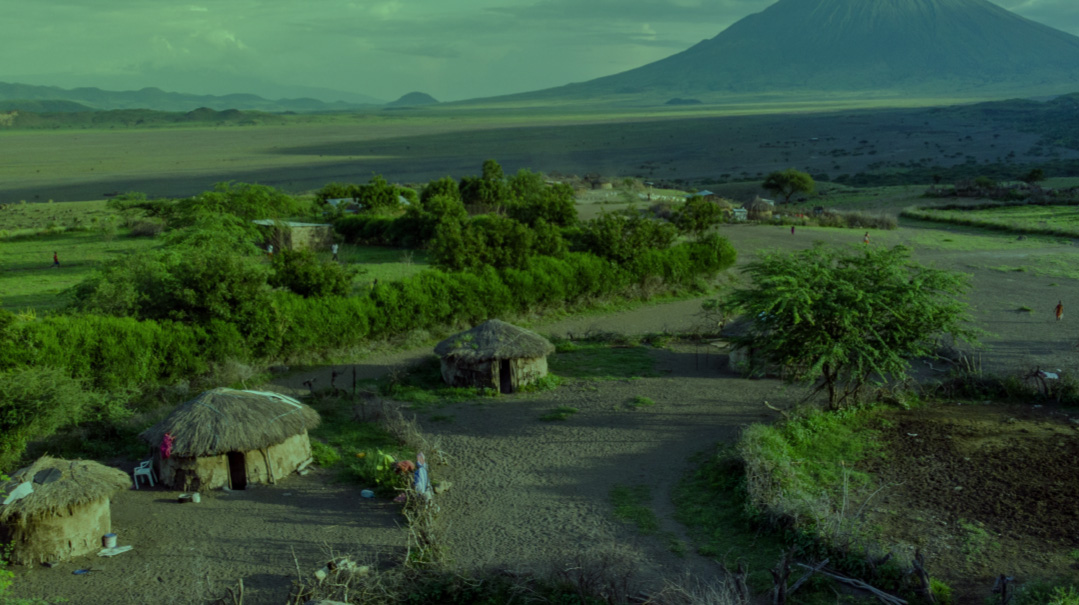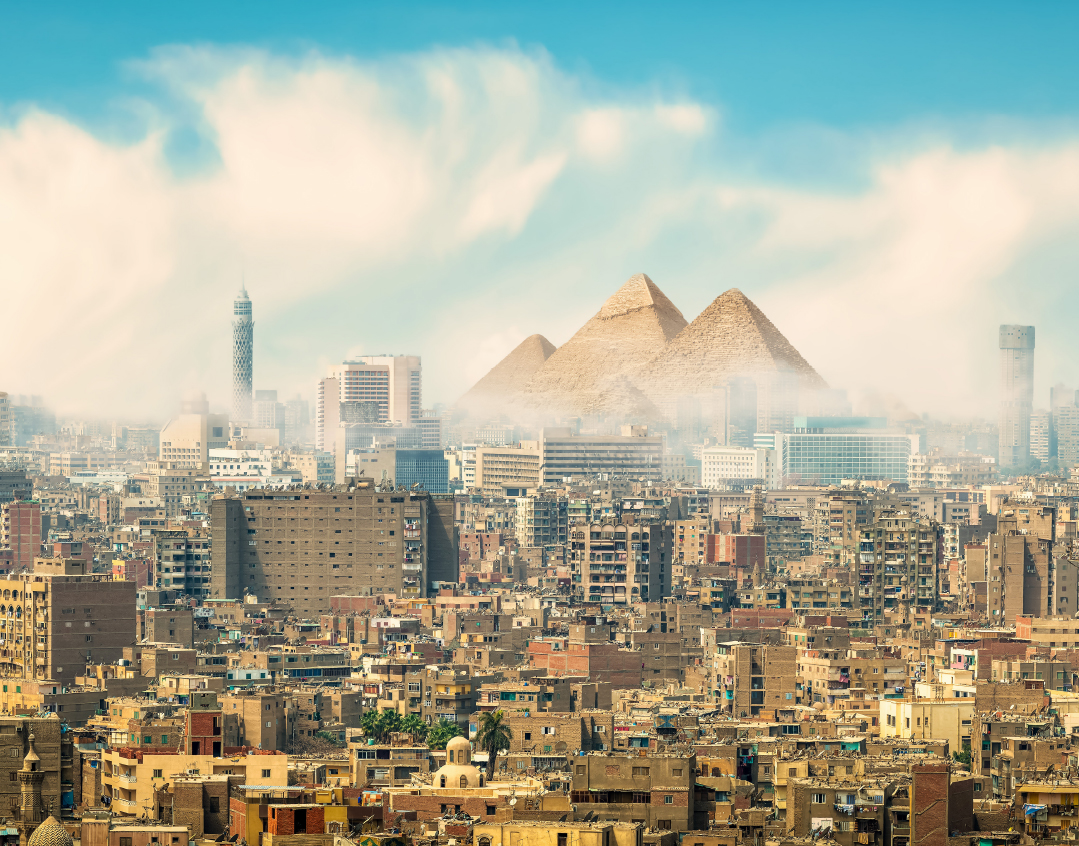Shifting Sands
| August 9, 2022Ari & Ari sift through the ancient land of Oman for traces of eternal truth
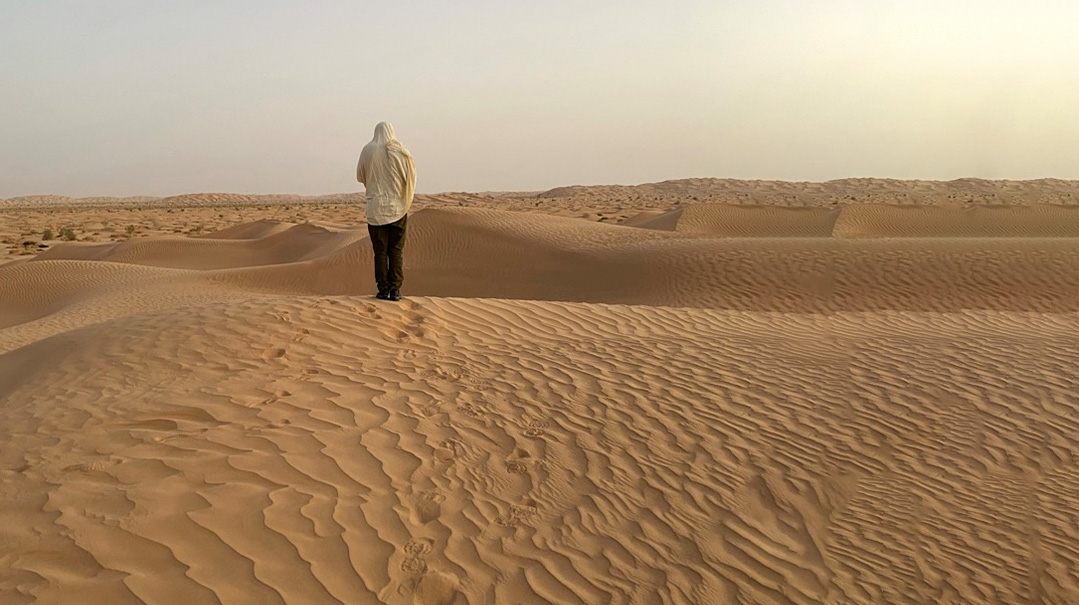
Text and photos: Ari Z. Zivotofsky and Ari Greenspan
Before Pesach of 2022, we set out on a first ever, hands-on matzah baking trip to the once hostile, now welcoming Persian Gulf, in order to prepare matzos with members of the small communities of Kuwait, Dubai, Abu Dhabi and Bahrain. Although for various reasons the planned bake with neighboring Oman’s small group of Jews didn’t happen in the end, we were glad we didn’t cancel our visit to the Sultanate of Oman at the southern end of the Arabian Peninsula. We made arrangements to visit the supposed grave of the prophet Iyov in Jabal Dhofar outside the city of Salalah, we traversed a small section of the world’s largest sand dune desert, and we found what was an oasis of calm in a region that roils, and natural, striking beauty not found elsewhere on the globe.
Of course, if we were solely interested in natural beauty, we’d head for the Alps instead. But if we were already in the region, maybe we could find some hints to shed light on the Jews who lived here, beginning some 1,200 years ago.
Although there is no Jewish community in Oman today, we know that there were Jews in Oman as early as the 9th century. A merchant trader named Ishaq ibn Yahuda made his fortune dealing with and sailing to China. The 12th century Jewish traveler Benjamin of Tudela visited Oman and described a Jewish community in the ancient city of Muscat, today Oman’s capital. There is a Jewish cemetery in the town of Sohar from the 19th century, and in the 1830s, British Lieutenant James Wellsted, who wrote about his groundbreaking visit to Oman in his book, Travels in Arabia, made mention of a small Jewish community in Muscat populated primarily by Baghdad expats. Lieutenant Wellsted wrote that unlike in other Arab countries, there was no Jewish ghetto in Oman and Jews were not discriminated against at all. When the Allies arrived during World War II, they also encountered a small group of Yemenite Jews.
Oman is a most beautiful, sedate and relaxed country. Qaboos bin Said Al Said, the sultan of 50 years who passed away in 2020, was a beloved and appreciated ruler, thoughtful and benevolent, who brought the sultanate into the 21st century by improving education, health and quality of life for this breathtaking country. While Israel does not have official diplomatic relations with Oman, there have been under-the-table contacts for decades. In fact, in 2021, then-Prime Minister Binyamin Netanyahu made a surprise trip to the palace for geopolitical discussions the sultan.
What’s so special about Oman that it warranted a secret visit? First of all, it sits on the strategic Straits of Hormuz, a mere 29 kilometers from Iran at its choke point, where 30 percent of the world’s liquified natural gas and 25 percent of the world’s oil pass through it on tankers. It’s the most strategic spot on all of the world’s oceans, and anything impeding naval traffic there would cause financial tsunamis worldwide — driving the price of oil sky high and by extension, everything else. But most importantly, Oman has been a quiet middleman between countries in the region, because of its accepted position an honest broker.
Oman is surrounded by two ocean borders — the Indian Ocean to the south and the Arabian Sea to the east, and three land borders — United Arab Emirates to the north and Saudi Arabia and Yemen to the west. As we’ve always been fascinated with Yemen and its Jews but unable to visit because of the extremist Muslim environment, we took the opportunity to soak in the very similar culture.
In our encounters, we found the people of Oman to be gentle, friendly and very welcoming. We almost felt a serenity from the people we interacted with. What is it about two adjacent countries with similar inhabitants where one is serene and the other is a boiling pot? Dubai, for example, is brash, noisy, full of bling, supercars and temptations. The people of Abu Dhabi, a mere hour drive away, dress the same but are more conservative, and less brazen and expressive.
It’s really a bit misleading when one sees a Muslim from the gulf dressed in a long white dishdasha and white turban-like headgear. These men look very religious and possibly even extremist Muslim, but while devout, many are actually very modern. The long white robes of the gulf are often less a religious expression than a cultural one. In the Emirates, as in Oman, many seek higher education, and international business strongly speaks to them. For many, money is what drives them. Everywhere we went, people seemed to be talking with us about their businesses and the deals they were doing.
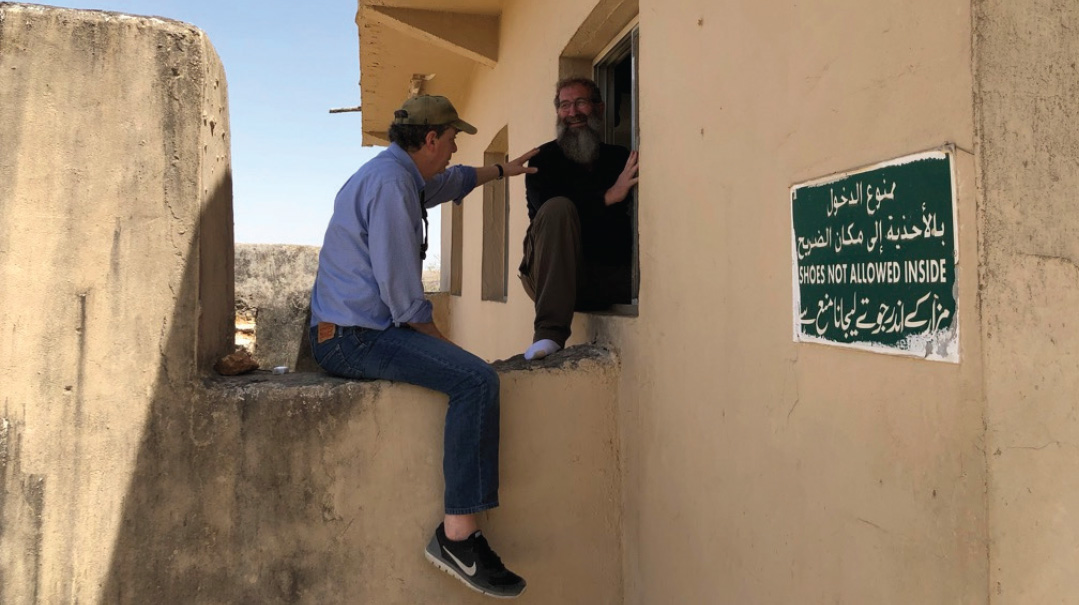
Having to climb through a window to get into Iyov’s tomb was no deterrent to our little group.
Rest for the Weary
The countryside in Oman is not exactly on the western tourist’s map, and that’s really a shame — although maybe that’s why it still has its simple and untarnished charm. We didn’t know about that before — but we found out as soon as Oman hit our traveling agenda: That’s because we couldn’t conscionably be in the region and not pay a visit to the Tanach hero Iyov, who is said to be buried in Oman. And so, we flew from matzah baking in Kuwait via Doha, Qatar, to Salalah, Oman, in order to visit the grave of the man Hashem afflicted with composite troubles.
Iyov (Job in English) lost his wealth, his health and his family. Yet, he never lost his faith in Hashem.
There are multiple opinions as to the identity of Iyov. A common view places Iyov’s birth at the time of the Jewish descent into Egypt and his passing at the time of the Exodus, fitting in with the Talmudic teaching that Iyov was one of three royal advisors (along with Bilaam and Yisro) to Pharaoh, who had been deliberating over the plot to murder all the male Jewish newborns. Upon learning of the proposal, Iyov didn’t protest the decree and it was because of his inaction that G‑d later brought immense suffering upon him. Other opinions place Iyov either during the era of the Meraglim, the Shoftim, the returnees from Bavel, or during the time of Avraham.
Either way, we wondered what he was doing out here deep in the Omani desert? In fact, this is only one of three supposed gravesites of Ivov. Another is in the village of Deir Ayyoub near Ramle, and a third is in Istanbul.
We were told before we arrived that the grave of Iyov was closed, but we have lots of experience with these things, and one locked fence wasn’t something we couldn’t work around.
Still, the gates to the gardens around the small building were all locked up. There was one Omani man sitting in the completely empty parking lot next to the locked tomb trying to sell us some nectarines. The nectarine man motioned with his hands that we should just climb onto the gate and go in. That was good enough for us, so up and over we went. The small structure is surrounded by deep, dry ravines with sharp, stony points all around, and dry shrubs and stunted trees surviving by somehow drawing water out of the dry rocks and earth. We tried the locked door with no luck, but through the wide- open windows we saw the grave on the floor in the Muslim style with a large ornate green covering on it. Head and footstones bracketed the burial place and Muslim art adorned the walls. We aren’t getting any younger, and barely succeeded in folding ourselves in through the windows.
The Koran mentions multiple prophets and holy characters, including Avraham, Yitzchak, Yaakov, Yosef, Moshe, and many more. Muslims, too, view them as holy and that is why they venerate them and sanctify their tombs (just look at the Mearas Hamachpeilah in Chevron to understand that). Thus, it was no surprise when we saw a drawing of a family tree of all of the prophets mentioned in the Koran. We related the story of Iyov’s sad life and sang a moving Keil Malei Rachamim prayer in Iyov’s memory. (Not having the most harmonious voices, we joked that Iyov, having suffered terribly in his lifetime, finally found comfort in his death only to suffer again when we started to sing to him.)
After leaving the tomb, we bought some nectarines from the nice salesman in the parking lot. As we drove away, we asked our Omani tour guide if we overpaid. In a quiet, reserved manner, not wanting to say lashon hara over the gouging we took, he looked at us smilingly and said, “Well, he is the only one selling nectarines in the parking lot today.”
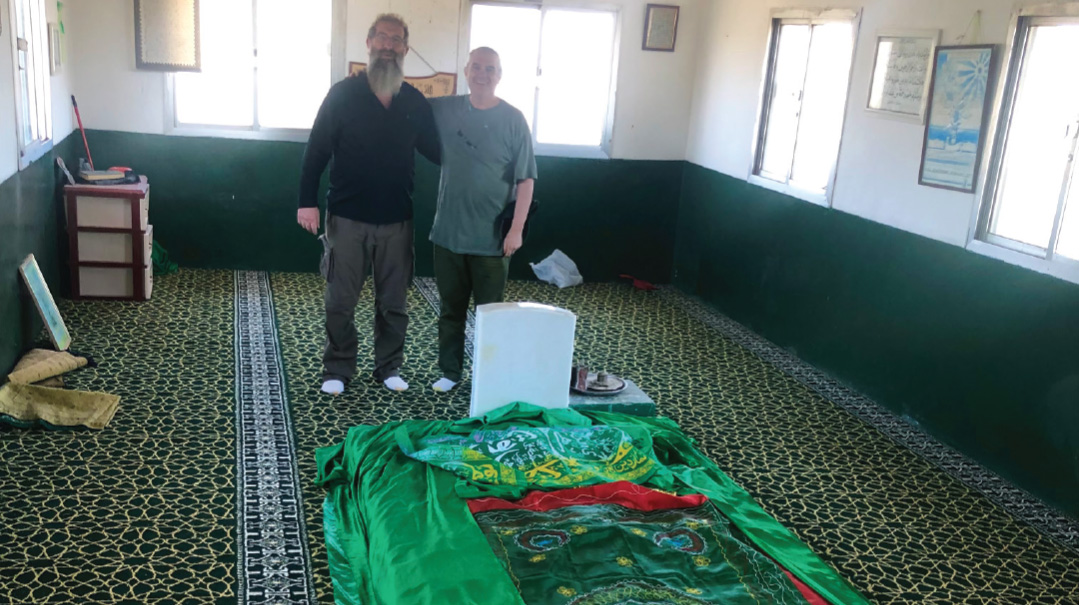
Once inside Iyov’s tomb fellow traveler Rabbi Eliyahu Birnbaum and Ari G. offered up a tefillah for the soul of the king of suffering
The Incense Trail
The Ketores, or incense of the Beis Hamikdash, was made from a combination of very expensive and rare substances that when perfectly measured and balanced and then thrown on a fire, produced an exceptional aroma. The components were balms and spices including amber, cinnamon, saffron, musk and a component that made the smoke rise in a straight line. One of those ingredients is “levonah,” which is generally translated as Frankincense. This spice literally has its roots in Oman. Frankincense is an aromatic resin derived from the hardened sap of the Boswellia tree that in the ancient world primarily grew in the dry rocky desert of Oman. In a bygone world, caravans of hundreds of camels would travel thousands of miles from the present-day capital Muscat, over the deserts for weeks on end arriving at the Red Sea in Yemen and turning north to Saudi Arabia. Once these products arrived in Jedda, they were shipped to Egypt where the Pharaohs and kings prized the levonah for its pleasant odor, and also for its healing properties. (Levonah, which was used in ancient cultures for healing respiratory ailments, was repurposed by some people in Eretz Yisrael who believed it would help them through Covid.)
From there the levonah found its way to Lebanon, Turkey and Greece and later Rome. The frankincense passing through Eretz Yisrael from Oman and Yemen must have been purchased for the Beis Hamikdash. Fragments found in the Cairo Genizah reflect a debate between the rabbanim and the Karaites regarding using incense to give a sweet smell in the synagogue. The rabbanim permitted it and the Karaites didn’t. Frankincense is still widely used by the Greek Orthodox and Catholic church in their service. The 50 tons used annually by the Catholic Church alone puts the sustainability of this tree at risk.
Incense is part of the culture here. As you walk through the market there are what look like little altars wafting smoke with the aroma into the air. These pretty little pottery holders contain a red-hot coal and when you sprinkle a little balsam on the coal it generates a sweet smell. In fact, the Gemara relates the custom of “mugmar,” bringing out incense at the end of the meal to enjoy and make a brachah over. So we were excited to discover, while ambling through the incense market in Salalah, that those little pottery containers are called “majmar” in the local jargon.
These aromas are part of the culture of the East. When we ate in the house of Jewish Yemenites in Abu Dhabi, they placed something like this on the table. It was not unpleasant, even to our bland western tastes, but not really something most of us would choose to have in our homes.
Frankincense is sold in barrels and looks like little rocks, but we wanted to see where those “rocks” originated. We were directed to the specific valley where the oldest trees are. When you cut a slice off the tree, sap immediately starts to flow, with the sweet smell of frankincense. This is done three times on the same cut over six weeks and then the initially sticky sap becomes dried and feels like a rock. These trees are becoming rare, and the entire valley is now a UN heritage site. But we tried to imagine what it was like thousands of years ago, when the caravans would travel through the desert for weeks on end just to trade the sap of a tree.
Got Your Goat
We didn’t have to stretch our imaginations for long. Because once we realized that we would be spending the night in Salalah in order to visit Iyov’s tomb, we looked at what else could be done there. We saw online that overnight camping tours of the desert were available — and that didn’t mean dirt roads over a rocky desert with the last gas station only five miles back, but rather what was more like an endless expanse of sand dunes.
We drove for hours, not seeing another person, until we reached the place where we camped: a small depression between the dunes. This is the desert of your imagination. A massive 250,000 square miles of nothing. Dunes can be hundreds of feet high and you can go desert skiing down them if you wish. Some people do aggressive 4X4 driving safaris, jumping into the air as they fly over the top of a dune. In fact, our guides parked the vehicle few hundred feet below our camp so should one of those drivers come by, he would know that people were camped in the area and not kill us.
Being Jewish, food is near and dear to our hearts. We didn’t give too much thought to what we’d eat, though, assuming it would be fruits and veggies and some tuna. We contacted the guide before we arrived and asked what they normally provided. He said that they cook a traditional Omani Bedouin BBQ. “What’s that?” we asked. “Camel meat and various birds,” he responded.
Now, for some travelers that might be a challenge. But not for us halachic adventurers. Not yet wanting them to know that we were Jewish and recalling that one of our companions had an impressive beard of prodigious dimensions, we explained to our guide that we were coming with a very important imam, or Muslim religious leader, and that he is so religious that he only eats “special Halal,” a concept we made up on the spot so that they could understand special food needs. Packing my shechitah knives, we explained that our imam needs to see the actual slaughter of the animal for it to be fit to eat. We then told them we would buy new pots and utensils, all of which we gave to them as a gift in order to avoid having to toivel them. Finally, we asked them to procure a goat for us to shecht in the desert. That, he replied, was no problem. So off we went to the desert.
We shechted a goat and baruch Hashem it was glatt kosher. We kashered it not by soaking and salting, as there is no water in the sands, but rather over an open fire with some salt, much like liver is made kosher. The Bedouin chef provided vegetables and we cooked up a gastronomic feast. The guides opened a table and folding chairs and in darkness with the glowing embers of the fire keeping us warm in the chill of the desert night, we reclined and enjoyed the fruits of our planning. It was with awe that we leaned back and peered at the mesmerizing night sky and complete silence and the oft-forgotten beauty of Hashem’s glorious world.
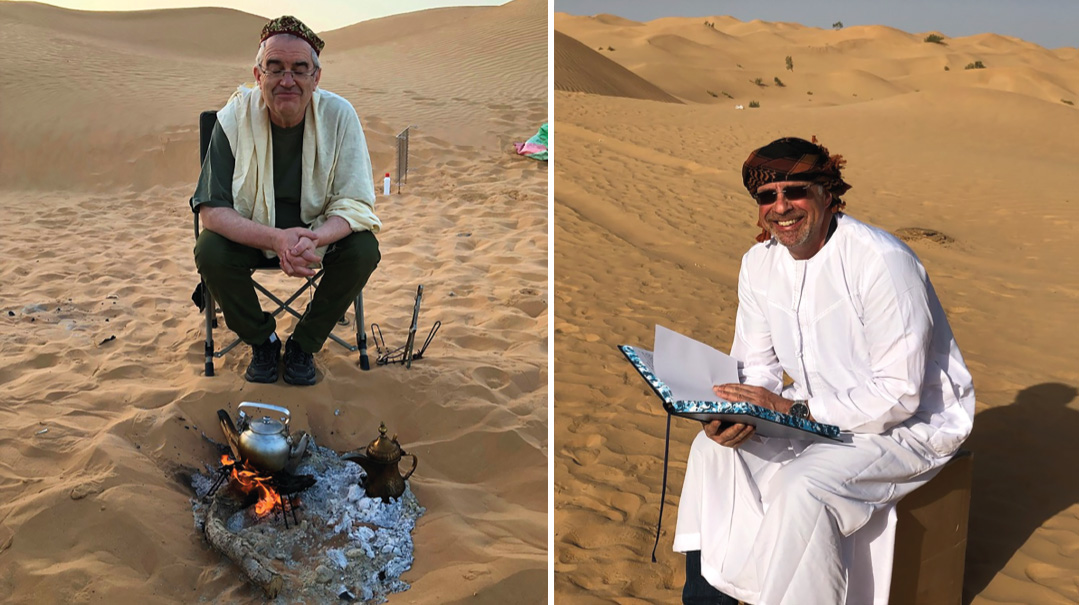
By the time sunrise came along, it didn’t matter to our guides that we were Jews. Somehow the desert does that. Our companion Chaim Guggenheim even took out a Gemara to learn the day’s daf
Sands of Time
There is no sound other than the near constant whoosh of the wind, and when the sun goes down, the sky becomes a blend of riotous colors. It’s the exact description of bein hashmashos, twilight, with the red colors disappearing into blues and silvers of night.
And the stars… Most of us in the western world today have never seen the night sky in its glory. Light and air pollution, even if it’s many tens of miles away, minimizes our ability to see in the dark. In the desert, when the sun set and the stars came out, it was a sky we didn’t recognize. We thought about all of the halachos based on the transition from light to dark and back to light. When the mishnah tells us that the time of reading the Shema in the morning is when there is enough light to distinguish between the techeles blue string and the white strings of the tzitzis, we experienced that in the morning with no man-made illumination at all.
Our guides were religious Muslims and the elder of the three was a traditional yet worldly Omani Bedouin. He spoke a fluent English, but a city man he’s not — he often likes to go out alone in the desert for days at a time. These religious Muslims would go off to a dune peak nearby to pray out loud. So we did the same on another nearby dune — by this time, it really didn’t matter to them that we were Jews. Somehow the desert made us all feel like comrades.
We talked Torah into the black night and in particular, we discussed the travails of Jewish travelers throughout the ages. We’ve been in some tough spots over the years, particularly before the internet and cell phones, and yet those things were a breeze compared to the times before automobiles and electricity. Yet here in the wilds of Oman, with no internet access or cell reception or even concerns about being identified as Jews, we could feel at one with all of our brothers from centuries past who endured these fears and privations. It’s no wonder the halachah tells us about four people who have to make the brachah “Hagomel” — one who was sick and recovered, one who was in jail but got released, one who crossed the sea and one who crossed a desert and survived. Our location in Oman was the type of desert the Gemara meant. Another related discussion in the Gemara is about joining a caravan if chances are good that it will not stop for Shabbos. While such questions often seem unrelatable, peering into the endless sands gave us a greater appreciation for the difficulties our ancestors faced.
At dawn, our Muslim guides got up and faced Mecca 2,500 kilometers away, and we put on our talleisim and tefillin and faced Jerusalem. We ate breakfast, bentshed and sang, and our traveling companion Chaim Guggenheim even took out his Gemara to learn the daf yomi.
And although Israel doesn’t yet have official relations with Oman, we proved that there are no politics in a desert.
(Originally featured in Mishpacha, Issue 923)
Oops! We could not locate your form.

